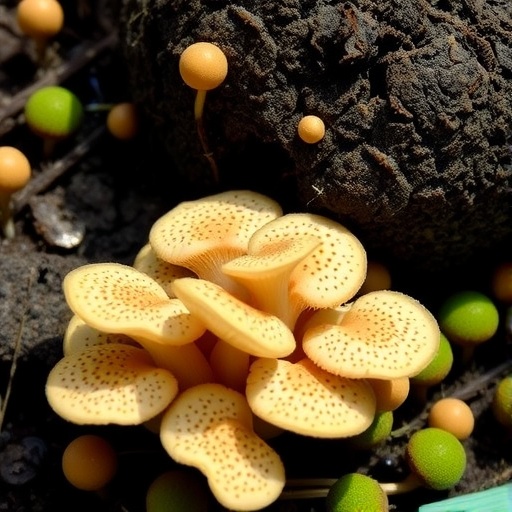In the depths of urban environments, a hidden and complex world thrives beneath our feet – one that holds the potential to reshape our understanding of ecological interactions and urban biodiversity. A new research article published in the journal Ambio unveils the fascinating realm of ectomycorrhizal fungi, a group of organisms playing a vital role in forest ecosystems but whose significance in urban areas remains largely unexplored. Authored by researchers Authier, Richard, and Violle, this groundbreaking study titled “Hundreds of fungi under the city: Opportunities and challenges of ectomycorrhizal research and application in urban spaces” presents a comprehensive examination of the opportunities for research and application of these fungi in urban settings.
As cities continue to expand, the relationship between urbanization and ecosystems becomes increasingly critical. Urban environments, once thought to be devoid of biodiversity, present unique challenges that affect the microbial communities within the soil. Ectomycorrhizal fungi form symbiotic relationships with the roots of various tree species, aiding in nutrient uptake and enhancing plant health. The authors underscore the idea that urbanization may disrupt these intricate relationships, yet simultaneously offers a unique opportunity to study how these fungi adapt to changing environments.
The article highlights that ectomycorrhizal fungi are not just limited to rural or forested areas. Many urban trees, particularly those in parks and along streets, also rely on these fungi for their growth and survival. This connection prompts the authors to emphasize the urgent need for urban mycology research to understand how these fungi can influence urban forestry practices. Urban trees play an essential role in mitigating climate effects, enhancing air quality, and providing aesthetic beauty, all of which are improved by healthy mycorrhizal relationships.
One of the most striking aspects presented in this research is the diversity of ectomycorrhizal fungi found in urban settings. The authors reveal evidence that hundreds of different fungal species exist beneath city landscapes, challenging previous assumptions that urban soils were biologically depleted. They advocate for more comprehensive surveys and mappings of fungal biodiversity in urban areas, as understanding these communities is crucial for promoting tree health and urban greening initiatives.
Through their investigation, the researchers touch upon the role of environmental variables in determining the composition of ectomycorrhizal communities in urban soils. Factors such as soil compaction, pollution, and water availability can significantly impact fungal diversity. By identifying specific environmental stressors, urban planners and ecologists can work together to restore and enhance urban ecosystems. The challenge lies not only in understanding these interactions but also in conceptualizing how to implement strategies that leverage ectomycorrhizal fungi for better urban resilience.
Moreover, the potential applications of ectomycorrhizal fungi in urban landscaping and remediation offer an exciting frontier. The authors propose that using these fungi in urban planning could improve soil structure, enhance nutrient availability, and even aid in bioremediation efforts to tackle pollutants. The implications for sustainable urban development are profound, as cities could leverage natural processes facilitated by these fungi to create more resilient and healthy urban habitats.
However, this research doesn’t shy away from discussing the challenges that lie ahead. Urban mycology is still a nascent field, and many practical and theoretical hurdles remain in the way of harnessing ectomycorrhizal fungi in urban agriculture and forestry. Standardized research methods, funding for ecological studies in urban settings, and the need for collaboration between mycologists, urban planners, and ecologists are highlighted as critical areas that require immediate attention.
The authors also rightly point out the societal dimension of urban mycology. Engaging city residents in learning about and participating in mycological practices could foster a deeper connection between communities and their urban environments. Initiatives that educate the public about the importance of fungi could promote conservation efforts and encourage the planting of fungi-associated trees, fostering biodiversity and enhancing urban living conditions.
As we stand on the brink of a new understanding of how urbanization interplays with complex biological networks, this research drives home an essential message: the urban environment is not an enemy to nature but a landscape replete with potential. By embracing the study of ectomycorrhizal fungi, cities could transform into vibrant ecosystems that support both human life and biodiversity.
The findings of this study underline an expanding frontier of research that promises to yield significant insights into urban biodiversity and sustainability. The collaboration across various disciplines will play an increasingly vital role in uncovering the depths of how urban systems function, ultimately providing beneficial solutions to urban challenges. The future of urban ecosystems may well depend on how effectively we harness the power of fungi hidden beneath our city’s surface.
As society grapples with climate change and urban pressure, the research brings to light an exciting call to action. Urban mycology, grounded in the science of ectomycorrhizal associations, can illuminate pathways toward greener, healthier cities. Not only could this exploration yield immediate benefits for urban forestry, but it may also enrich the lives of urban residents, connecting them to the natural world in unexpected and vital ways.
In conclusion, the intricate world of ectomycorrhizal fungi holds significant potential for urban ecology, offering both challenges and exciting prospects for researchers and urban planners alike. As cities evolve, so too should our understanding of the biological networks that sustain them. This study aims to be a powerful catalyst for future investigations, urging stakeholders to recognize the fungal life beneath our feet and take action toward a greener urban future.
Subject of Research: Urban Ectomycorrhizal Fungi
Article Title: Hundreds of fungi under the city: Opportunities and challenges of ectomycorrhizal research and application in urban spaces.
Article References:
Authier, L., Richard, F. & Violle, C. Hundreds of fungi under the city: Opportunities and challenges of ectomycorrhizal research and application in urban spaces.
Ambio (2025). https://doi.org/10.1007/s13280-025-02296-5
Image Credits: AI Generated
DOI: 10.1007/s13280-025-02296-5
Keywords: Urban Ecology, Ectomycorrhizal Fungi, Biodiversity, Urban Forestry, Resilience, Mycology, Sustainability, Urban Greening.




